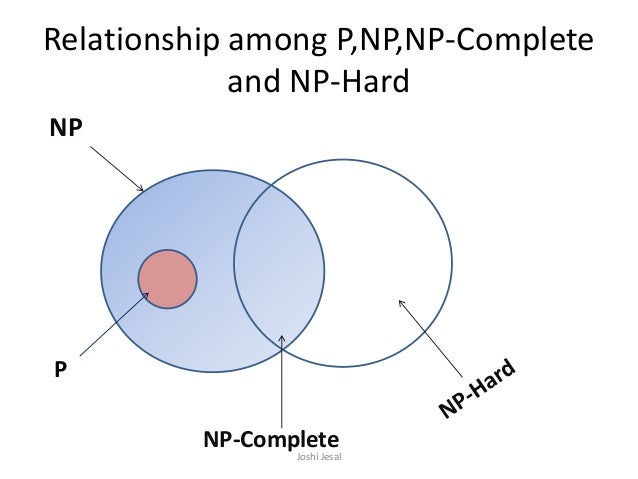P vs NPSatisfiabilityReductionNP-Hard vs NP-CompleteP=NPPATREON: Ignore Spelling MistakesCourses on U. May 08, 2020 NP-hard NP-Complete; NP-Hard problems(say X) can be solved if and only if there is a NP-Complete problem(say Y) can be reducible into X in polynomial time. NP-Complete problems can be solved by deterministic algorithm in polynomial time. To solve this problem, it must be a NP problem. To solve this problem, it must be both NP and NP-hard problem. NP-Complete', this will imply that if Lis in P, then P = NP; we will take this as being very strong evidence that L=2P. NP-Completeness De nition 2. Then we say Lis NP-Complete if: 1) L2NP and 2) For all L02NP, L0 p L. If Lsatis es the second condition in the de nition of NP-completeness, we say Lis (ManyOne)-NP-Hard.
- Design and Analysis of Algorithms
- Basics of Algorithms
- Design Strategies
- Graph Theory
- Heap Algorithms
- Sorting Methods
- Complexity Theory
- DAA Useful Resources
- Selected Reading
A problem is in the class NPC if it is in NP and is as hard as any problem in NP. A problem is NP-hard if all problems in NP are polynomial time reducible to it, even though it may not be in NP itself.
If a polynomial time algorithm exists for any of these problems, all problems in NP would be polynomial time solvable. These problems are called NP-complete. The phenomenon of NP-completeness is important for both theoretical and practical reasons.
Definition of NP-Completeness
A language B is NP-complete if it satisfies two conditions

B is in NP
Every A in NP is polynomial time reducible to B.
If a language satisfies the second property, but not necessarily the first one, the language B is known as NP-Hard. Informally, a search problem B is NP-Hard if there exists some NP-Complete problem A that Turing reduces to B.
The problem in NP-Hard cannot be solved in polynomial time, until P = NP. If a problem is proved to be NPC, there is no need to waste time on trying to find an efficient algorithm for it. Instead, we can focus on design approximation algorithm.
NP-Complete Problems
Following are some NP-Complete problems, for which no polynomial time algorithm is known.
- Determining whether a graph has a Hamiltonian cycle
- Determining whether a Boolean formula is satisfiable, etc.
NP-Hard Problems
Np Complete Vs Np Hardclevelandmultifiles Scope
The following problems are NP-Hard
- The circuit-satisfiability problem
- Set Cover
- Vertex Cover
- Travelling Salesman Problem
In this context, now we will discuss TSP is NP-Complete
TSP is NP-Complete
Np Complete Vs Np Hardclevelandmultifiles Nursing
The traveling salesman problem consists of a salesman and a set of cities. The salesman has to visit each one of the cities starting from a certain one and returning to the same city. The challenge of the problem is that the traveling salesman wants to minimize the total length of the trip
Proof
To prove TSP is NP-Complete, first we have to prove that TSP belongs to NP. In TSP, we find a tour and check that the tour contains each vertex once. Then the total cost of the edges of the tour is calculated. Finally, we check if the cost is minimum. This can be completed in polynomial time. Thus TSP belongs to NP.
Secondly, we have to prove that TSP is NP-hard. To prove this, one way is to show that Hamiltonian cycle ≤p TSP (as we know that the Hamiltonian cycle problem is NPcomplete).
Assume G = (V, E) to be an instance of Hamiltonian cycle.
Hence, an instance of TSP is constructed. We create the complete graph G' = (V, E'), where
$$E^{'}=lbrace(i, j)colon i, j in V ::and:ineq j$$
Thus, the cost function is defined as follows −

Game 141: march 10 2017 the initials game on. $$t(i,j)=begin{cases}0 & if: (i, j): in E1 & otherwiseend{cases}$$
Now, suppose that a Hamiltonian cycle h exists in G. It is clear that the cost of each edge in h is 0 in G' as each edge belongs to E. Therefore, h has a cost of 0 in G'. Thus, if graph G has a Hamiltonian cycle, then graph G' has a tour of 0 cost.

Conversely, we assume that G' has a tour h' of cost at most 0. The cost of edges in E' are 0 and 1 by definition. Hence, each edge must have a cost of 0 as the cost of h' is 0. We therefore conclude that h' contains only edges in E.
We have thus proven that G has a Hamiltonian cycle, if and only if G' has a tour of cost at most 0. TSP is NP-complete.